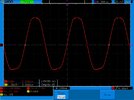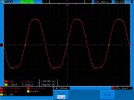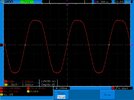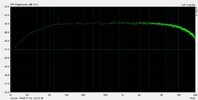There has been a lot of interest in the small 5K output transformers that come out of tape recorders and how suitable they may be for HiFi amps, so Electrovice was kind enough to lend me an Akai and a Sony unit for testing. In order to test the iron, I will measure inductance with no DC current, then apply DC current to determine how much current can be run through these. After that I will install each transformer in some Paramour II amps setup to run 45s so I can test bandwidth, power, and distortion in this iron.
First up, the primary inductance and current tests!
Sony: 15H at 0mA DC, primary current should be no more than 50mA.
Akai M8: 24H at 0mA DC, primary current should be no more than 40mA.
One-Electron UBT-2: 25H at 0mA DC, primary current can exceed 100mA (my test setup doesn't go above 100mA).
Now for power, bandwidth, and distortion tests.
Sony:

Here's the Sony at 1kHz and 2.8W at 10% THD.

Here's the Sony's frequency response at 1W. This OT is -1dB at abt 39Hz and 12kHz.
At 35Hz, the Sony did 1.3W at 35Hz/10% THD.
Akai:

This is the Akai doing 2.4W at 1kHz and 10% THD.

Here's the Akai's frequency response at 1W. This OT is -1dB at about 32Hz and 8kHz. I flipped the primary connections around to see if this could be improved, but it is what it is.
At 35Hz, the Akai did 15W at 10% THD.
One-Electron:

This is the One-Electron doing 2.9W at 1kHz and 10% THD

Here's the One-Electron's frequency response at 1W. This OT is -1dB at 22Hz and 16kHz.
At 35Hz, the UBT-2 did 2W at 10% THD.
As a little bonus data point, I put a Magnequest RH-60 in the mix. It did 3.4! watts at 1kHz and 10% THD and was -1dB at 28Hz and 14kHz.
I was quite sure that the Akai would beat the Sony, as the Sony has that 600 ohm winding working against the high frequency response, but that wasn't the case at all. Sure, the Akai goes lower, but the Akai has nothing going on up top. Naturally the two newer and more expensive output transformers are quite a bit better, but at the end of the day the plate impedance of the #45 starts to limit the performance of these transformers (just plugging in a 2A3 into the same circuit is going to flatten things way out!).
I also tried connecting the 600 ohm winding on the Sony as a feedback winding and that helped the bass tremendously (now -1dB at 22Hz), but the treble response started to look a lot like the Akai. There is probably happy medium where the feedback winding is used to get that nice bass response and a driver cathode resistor could be bypassed by a small capacitor to nudge the treble up a bit more.
First up, the primary inductance and current tests!
Sony: 15H at 0mA DC, primary current should be no more than 50mA.
Akai M8: 24H at 0mA DC, primary current should be no more than 40mA.
One-Electron UBT-2: 25H at 0mA DC, primary current can exceed 100mA (my test setup doesn't go above 100mA).
Now for power, bandwidth, and distortion tests.
Sony:

Here's the Sony at 1kHz and 2.8W at 10% THD.

Here's the Sony's frequency response at 1W. This OT is -1dB at abt 39Hz and 12kHz.
At 35Hz, the Sony did 1.3W at 35Hz/10% THD.
Akai:

This is the Akai doing 2.4W at 1kHz and 10% THD.

Here's the Akai's frequency response at 1W. This OT is -1dB at about 32Hz and 8kHz. I flipped the primary connections around to see if this could be improved, but it is what it is.
At 35Hz, the Akai did 15W at 10% THD.
One-Electron:

This is the One-Electron doing 2.9W at 1kHz and 10% THD

Here's the One-Electron's frequency response at 1W. This OT is -1dB at 22Hz and 16kHz.
At 35Hz, the UBT-2 did 2W at 10% THD.
As a little bonus data point, I put a Magnequest RH-60 in the mix. It did 3.4! watts at 1kHz and 10% THD and was -1dB at 28Hz and 14kHz.
I was quite sure that the Akai would beat the Sony, as the Sony has that 600 ohm winding working against the high frequency response, but that wasn't the case at all. Sure, the Akai goes lower, but the Akai has nothing going on up top. Naturally the two newer and more expensive output transformers are quite a bit better, but at the end of the day the plate impedance of the #45 starts to limit the performance of these transformers (just plugging in a 2A3 into the same circuit is going to flatten things way out!).
I also tried connecting the 600 ohm winding on the Sony as a feedback winding and that helped the bass tremendously (now -1dB at 22Hz), but the treble response started to look a lot like the Akai. There is probably happy medium where the feedback winding is used to get that nice bass response and a driver cathode resistor could be bypassed by a small capacitor to nudge the treble up a bit more.


